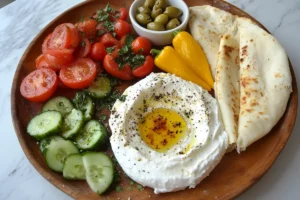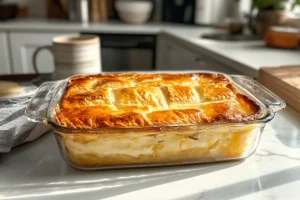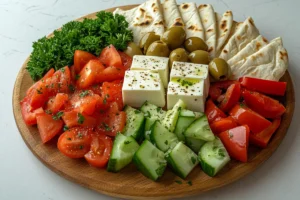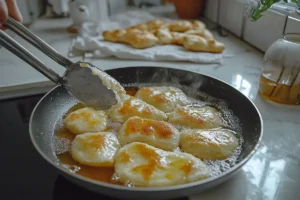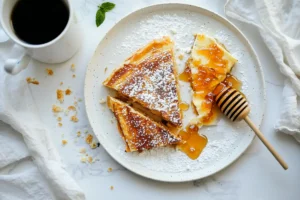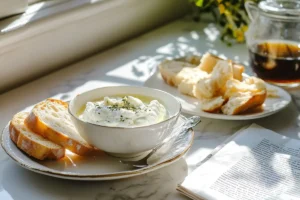What is a typical Balkan breakfast? That’s a question I get asked a lot, especially by readers who are curious about simple yet flavorful ways to start their day. Balkan breakfasts are more than just food—they’re a warm, inviting ritual full of fresh ingredients, rich traditions, and cozy moments shared around the table.
When I first explored these breakfast traditions, I was reminded of mornings in my grandmother’s Brooklyn kitchen. While it wasn’t exactly Balkan, her love for rustic, homemade meals helped shape my approach to cooking—simple, hearty, and made with love. That same feeling lives in every Balkan breakfast I’ve tasted.
You won’t find complicated techniques or hard-to-source ingredients here. What you will find is a beautiful balance of fresh veggies, creamy cheeses, warm breads, and satisfying flavors. And the best part? These meals come together quickly—perfect for busy mornings.
In this article, I’ll walk you through what a typical Balkan breakfast really looks like. I’ll also share a few quick, tasty ideas you can easily make at home—even if you’ve never cooked a Balkan dish before. Trust me, by the end, you’ll want to try one tomorrow morning.
Ready to dig in? Let’s go!
Exploring the Components of a Typical Balkan Breakfast
So, what is a typical Balkan breakfast made of? The answer lies in a mix of rustic, homemade flavors that are both comforting and incredibly satisfying. Here’s what you’ll usually find on a traditional breakfast table across the Balkans.
Fresh Vegetables – The Heart of the Plate
Fresh, raw vegetables are a must. They’re crisp, juicy, and add balance to the richness of other breakfast items.
- Sliced tomatoes
- Crunchy cucumbers
- Bell peppers (usually red or green)
- A handful of olives on the side
These simple veggies don’t need fancy dressing. A pinch of salt and a drizzle of olive oil is all it takes. I love how these remind me of the garden my grandmother used to tend—straightforward and full of flavor.
Breads and Pastries – The Comfort Factor
Bread is always on the table, whether it’s crusty homemade loaves or delicate pastries.
- Banitsa: A flaky pastry filled with eggs and cheese. It’s one of the most iconic Balkan breakfast dishes.
- Mekitsa: Fried dough, soft on the inside and golden on the outside. You can serve it sweet or savory.
- Lepinja or Pita Bread: Soft, pillowy flatbread that’s perfect for scooping up cheese or vegetables.
Every time I bake banitsa, I remember the first time I had it at a small café in Sofia. It was warm, buttery, and unforgettable.
Cheeses and Dairy – Creamy, Tangy, Perfect
Cheese is a staple in a typical Balkan breakfast. The most common one?
- Sirene: A white brined cheese, very similar to feta but a bit creamier.
- Yogurt: Served plain, or sometimes with honey or fruit. It’s not just for spooning—you can dip your bread into it, too.
If you’ve never tried yogurt with honey and walnuts, please do. It’s simple, and oh-so-satisfying.
Proteins – Light, but Filling
Protein isn’t the star, but you’ll find it on the table.
- Boiled or scrambled eggs
- Cured meats like sudjuk (a spicy sausage)
But even without meat, what is a typical Balkan breakfast? It’s still full of flavor, texture, and balance.
That’s the beauty of it—it’s about variety, not complexity. And it’s exactly why I love making these kinds of meals in my own kitchen.
Tasty & Quick Balkan Breakfast Options
Now that you know what is a typical Balkan breakfast, let’s roll up our sleeves and dive into some easy, flavorful options you can whip up right at home. These are my go-to favorites—quick, satisfying, and filled with that rustic charm I adore.
Option 1: Classic Banitsa – Flaky, Cheesy, Comforting
Banitsa is a staple in the Balkans—and once you try it, you’ll understand why. It’s cheesy, flaky, and smells amazing while it bakes.
Ingredients:
- 1 pack phyllo dough (thawed)
- 4 eggs
- 1 ½ cups crumbled sirene (or feta cheese)
- 1 cup plain yogurt
- ½ cup sparkling water (Sylvia’s secret tip!)
- ½ tsp baking soda
- ½ cup melted butter or oil
Instructions:
- Preheat your oven to 375°F (190°C).
- In a large bowl, whisk eggs, yogurt, baking soda, and sparkling water.
- Stir in the cheese gently.
- Layer 2–3 sheets of phyllo in a greased baking pan.
- Brush with butter and spoon some of the filling over it.
- Repeat the layers until the filling is used.
- Finish with a few sheets on top and brush again with butter.
- Bake for 35–40 minutes until golden brown and puffed.
Sylvia’s Tip:
The sparkling water makes the filling extra airy. I picked up this trick from a sweet woman I met in Belgrade—it never fails.
Option 2: Fresh Vegetable & Cheese Platter – No-Cook Wonder
This is what I call my “lazy day breakfast”—no cooking required, just assembling. But trust me, it’s delicious and feels like a feast.
What You Need:
- 2 tomatoes, sliced
- 1 cucumber, sliced
- 1 bell pepper, sliced
- A handful of olives
- A few thick slices of sirene or feta
- Warm pita or rustic bread
- Olive oil, sea salt, and fresh parsley
Assembly Tips:
- Arrange everything on a big wooden board or platter.
- Drizzle olive oil over veggies and sprinkle salt.
- Add herbs like parsley or dill for extra aroma.
Sylvia’s Touch:
I like to toast the bread lightly and rub it with garlic—my grandmother used to do this with leftover bread, and it brings so much flavor.
Option 3: Mekitsa – Fried Dough with Sweet or Savory Twists
Mekitsa is a childhood favorite—soft, fluffy fried dough that you can top however you like. It’s perfect for lazy weekends.
Ingredients:
- 2 cups flour
- 1 cup plain yogurt
- 1 egg
- 1 tsp baking soda
- A pinch of salt
- Oil for frying
Instructions:
- Mix flour, yogurt, egg, baking soda, and salt into a soft dough.
- Let it rest for 15–20 minutes.
- Heat oil in a deep pan.
- Tear off small balls of dough and flatten with your hands.
- Fry until golden on both sides (about 2–3 minutes per side).
- Drain on paper towels.
Topping Ideas:
| Sweet | Savory |
|---|---|
| Powdered sugar | Sirene cheese |
| Jam or preserves | Yogurt and salt |
| Honey and walnuts | Cheese and olives |
Sylvia’s Memory:
Mekitsa takes me right back to snowy mornings in my childhood—my grandmother frying up dough while jam bubbled on the stove. That smell still makes me smile.
These three options are a perfect snapshot of what is a typical Balkan breakfast—warm, balanced, and deeply satisfying. Whether you cook or just assemble, you’ll taste the heart of Balkan mornings in every bite.
Cultural Insights and Variations
What is a typical Balkan breakfast without a little cultural flavor? The beauty of Balkan cuisine is how it changes from one region to another—each country adds its own twist, yet the core values stay the same: simplicity, warmth, and community.
Regional Differences:
- In Bulgaria, you’ll often see banitsa paired with a glass of ayran (a salty yogurt drink).
- In Serbia, lepinja (flatbread) might be served with kajmak—a rich, creamy dairy spread.
- Macedonian breakfasts sometimes include ajvar, a roasted pepper spread that’s spooned over bread or eaten with cheese.
- In Bosnia, you might find pita (a filled pastry) or even leftover savory pies from the night before, reheated and served with yogurt.
Each breakfast reflects the local ingredients and customs, but no matter where you are in the Balkans, you’ll always find familiar elements—cheese, bread, fresh vegetables, and that sense of comfort.
Modern Touches:
Today, many families are blending traditional flavors with modern habits:
- Using store-bought phyllo for banitsa instead of homemade dough
- Serving Balkan dishes as brunch-style spreads
- Adding smoothies or coffee alongside traditional items
No matter how you enjoy it, what is a typical Balkan breakfast today still honors its roots—simple, nourishing, and meant to be shared.
Sylvia’s Cooking Philosophy & Practical Tips
When people ask me, “What is a typical Balkan breakfast?” I always say—it’s not just about what’s on the plate. It’s about how you prepare it. My cooking philosophy is simple: use real ingredients, cook with care, and don’t overcomplicate things.
You don’t need to be a professional chef. All you need is:
- Fresh vegetables
- Quality cheese
- A few pantry staples like flour, eggs, and yogurt
Even if you can’t find sirene cheese, don’t worry—feta works beautifully. If you don’t have phyllo dough, try puff pastry. The goal isn’t perfection—it’s comfort, flavor, and joy in every bite.
Frequently Asked Questions
Q: What is a typical Balkan breakfast if I’m vegetarian?
Most Balkan breakfasts are naturally vegetarian! You’ll find plenty of options like banitsa, mekitsa, fresh veggies, cheeses, and yogurt without any meat involved.
Q: Can I prepare any of these breakfast dishes ahead of time?
Yes! Banitsa is great for meal prep—you can assemble it the night before and bake it fresh in the morning. Mekitsa dough can also be made ahead and kept in the fridge overnight.
Q: What can I substitute if I can’t find sirene cheese?
Feta cheese is the closest match and works just as well in most recipes.
I hope these ideas inspire you to bring a bit of the Balkans into your own kitchen. Try one of the options, tweak it to your taste, and most importantly—enjoy the process.
And hey, I’d love to hear from you! Share your breakfast creations and let’s keep the conversation going.

